Last changed:
~~LASTMOD~~

An Illustrated Guide to Rabbit Coat Colours*
*with an emphasis on Rex Rabbits (see the Rex Standard here)
<html>
<FORM action=https://www.paypal.com/cgi-bin/webscr method=post>
<INPUT type=image alt=“Make payments with PayPal - it's fast, free and secure!” src=“https://www.paypal.com/en_US/i/btn/x-click-but21.gif” border=0 name=submit>
<IMG height=1 textalign=“right” alt=“” src=“https://www.paypal.com/en_US/i/scr/pixel.gif” width=1 border=0 >
<FONT face=Verdana size=1 text-align=right><br>If you find this information useful, please consider making a [paypal] donation to help us maintain and improve it.</FONT>
<INPUT type=hidden value=_s-xclick name=cmd>
<INPUT type=hidden value=“—–BEGIN PKCS7—–MIIHXwYJKoZIhvcNAQcEoIIHUDCCB0wCAQExggEwMIIBLAIBADCBlDCBjjELMAkGA1UEBhMCVVMxCzAJBgNVBAgTAkNBMRYwFAYDVQQHEw1Nb3VudGFpbiBWaWV3MRQwEgYDVQQKEwtQYXlQYWwgSW5jLjETMBEGA1UECxQKbGl2ZV9jZXJ0czERMA8GA1UEAxQIbGl2ZV9hcGkxHDAaBgkqhkiG9w0BCQEWDXJlQHBheXBhbC5jb20CAQAwDQYJKoZIhvcNAQEBBQAEgYCNIsZLQA6jCbLiSI5lR2rDCJHPnld6VVzExEKczllfYWnPmzH1WY/bwqwv2pHs8brp3KW2DAdjX82+scemtUJFSyzcBrWWJjc1lQt6K/8YXJSAqbV0ptfkyM6VjdMwEBpjvr71qkqMesG6ALBJctuK2beqQoNWnLzPo/pQz4PjELMAkGBSsOAwIaBQAwgdwGCSqGSIb3DQEHATAUBggqhkiG9w0DBwQIw4Jvi5bH1/aAgbjFf5Pnsv64CM3nS4fVVeWi+6t1YJowAWB9Vn9suW4KoD4tLeKCQR3kP1yNHnuw+XgECTiTnLCJZ/pw7YSTqAT+ObYhnCY3KnEia9+RIMRw9c0Zi4dGogK2/HVGm/G+qNbqmxtscI+2K3up+zUBk9vOVwy4W+GP2Gjv7zZh3ZQCWQvPsDCDTf8oURPyP7bC/OKJ48paqbdrPGdURyenMVQZ4frZvknPutQ0R96MFcRHxtwij7Wn/B6toIIDhzCCA4MwggLsoAMCAQICAQAwDQYJKoZIhvcNAQEFBQAwgY4xCzAJBgNVBAYTAlVTMQswCQYDVQQIEwJDQTEWMBQGA1UEBxMNTW91bnRhaW4gVmlldzEUMBIGA1UEChMLUGF5UGFsIEluYy4xEzARBgNVBAsUCmxpdmVfY2VydHMxETAPBgNVBAMUCGxpdmVfYXBpMRwwGgYJKoZIhvcNAQkBFg1yZUBwYXlwYWwuY29tMB4XDTA0MDIxMzEwMTMxNVoXDTM1MDIxMzEwMTMxNVowgY4xCzAJBgNVBAYTAlVTMQswCQYDVQQIEwJDQTEWMBQGA1UEBxMNTW91bnRhaW4gVmlldzEUMBIGA1UEChMLUGF5UGFsIEluYy4xEzARBgNVBAsUCmxpdmVfY2VydHMxETAPBgNVBAMUCGxpdmVfYXBpMRwwGgYJKoZIhvcNAQkBFg1yZUBwYXlwYWwuY29tMIGfMA0GCSqGSIb3DQEBAQUAA4GNADCBiQKBgQDBR07d/ETMS1ycjtkpkvjXZe9k+6CieLuLsPumsJ7QC1odNz3sJiCbs2wC0nLE0uLGaEtXynIgRqIddYCHx88pb5HTXv4SZeuv0Rqq4+axW9PLAAATU8w04qqjaSXgbGLP3NmohqM6bV9kZZwZLR/klDaQGo1u9uDb9lr4Yn+rBQIDAQABo4HuMIHrMB0GA1UdDgQWBBSWn3y7xm8XvVk/UtcKG+wQ1mSUazCBuwYDVR0jBIGzMIGwgBSWn3y7xm8XvVk/UtcKG+wQ1mSUa6GBlKSBkTCBjjELMAkGA1UEBhMCVVMxCzAJBgNVBAgTAkNBMRYwFAYDVQQHEw1Nb3VudGFpbiBWaWV3MRQwEgYDVQQKEwtQYXlQYWwgSW5jLjETMBEGA1UECxQKbGl2ZV9jZXJ0czERMA8GA1UEAxQIbGl2ZV9hcGkxHDAaBgkqhkiG9w0BCQEWDXJlQHBheXBhbC5jb22CAQAwDAYDVR0TBAUwAwEB/zANBgkqhkiG9w0BAQUFAAOBgQCBXzpWmoBa5e9fo6ujionW1hUhPkOBakTr3YCDjbYfvJEiv/2P+IobhOGJr85+XHhN0v4gUkEDI8r2/rNk1m0GA8HKddvTjyGw/XqXa+LSTlDYkqI8OwR8GEYj4efEtcRpRYBxV8KxAW93YDWzFGvruKnnLbDAF6VR5w/cCMn5hzGCAZowggGWAgEBMIGUMIGOMQswCQYDVQQGEwJVUzELMAkGA1UECBMCQ0ExFjAUBgNVBAcTDU1vdW50YWluIFZpZXcxFDASBgNVBAoTC1BheVBhbCBJbmMuMRMwEQYDVQQLFApsaXZlX2NlcnRzMREwDwYDVQQDFAhsaXZlX2FwaTEcMBoGCSqGSIb3DQEJARYNcmVAcGF5cGFsLmNvbQIBADAJBgUrDgMCGgUAoF0wGAYJKoZIhvcNAQkDMQsGCSqGSIb3DQEHATAcBgkqhkiG9w0BCQUxDxcNMDcxMTMwMjAwNjQ3WjAjBgkqhkiG9w0BCQQxFgQUksa+GmavzkxvvXXoAWLfLtusQYYwDQYJKoZIhvcNAQEBBQAEgYB7OVn+c8kZrGablDfqfUGjUGwZCvLh3mnG8CvLjFdbxZzK1YBqe0TSGn2pqzti7eGrZ5F8gv+N2m043VMSPYH8a+uEF9KE8zL/1oGmTSCdgmvsCb0xRASc74rm9DJtfMFgKYYMzUkNguRAmBes0jg8LGPcHJUEW59nPNQEtS+3Xw==—–END PKCS7—– ” name=encrypted>
</FORM>
</html>
For a primer on the genes responsible for colour in rabbits, try this page.
 Please note that this page is still under construction - I will add descriptions, explanations, and photos as I get the chance.
It's one thing to lay out how the six main sets of genes can be combined, but another thing to look at how they are expressed in real rabbits. The descriptions below focus on Rex as that is my breed, but the ideas apply to all breeds. Where ever possible I have based descriptions on first-hand knowledge.
All genes come in pairs. In the case where a dominant gene is evident (i.e. is the one whose traits are visible), then the second gene of the pair cannot be known [it's hidden, or masked] and is indicated with a '-'. That second gene might be the same as the dominant one or one of the “lower ranking” genes of that group. Put another way, if there is a dominant gene then it will be the one you see. If there are two genes that are co-dominant or where one is not fully dominant over the other, you will see the effects of both.
There are two groups of colours that are treated alone: the broken group (En), and albino (red-eyed white) (cc).
The broken group is controlled by a separate set of genes from all the other colours and can be combined with ANY of them, so it is possible to talk about brokens and broken patterns without talking about any of the other colours they are carrying.
Albino comes from the Colour gene (C) and is recessive to all others. The effect of the albino gene is to PREVENT ALL COLOUR, so it makes no sense to talk about the albino gene in combination with any other colour (even broken) because if a rabbit is homozygous for albinism it is impossible to see what any of the other genes are - even though they are still there.
The colours below are organized first according to the Extension (E) and then according the the colour group which is determined by the C gene.
The steel gene (ES) is not included at this time.
====== Broken Group (En-) ======
Any recognized colour (plus harlequin) can be combined with the broken pattern in Rex. When a harlequin is combined with broken, it becomes a tri.
When the broken gene is homozygous, the result is called a “Charlie” - it usually has very little colour.
Most broken varieties need to be heterozygous (Enen) in order to have sufficient colour to be showable.
^ Colour ^ A ^ B ^ C ^ D ^ E ^ En ^ ^
| Broken | – | – | – | – | – | Enen | |
| Charlie | – | – | – | – | – | EnEn | |
| Self | – | – | – | – | – | enen | All of the selfs are homozygous enen |
|
Please note that this page is still under construction - I will add descriptions, explanations, and photos as I get the chance.
It's one thing to lay out how the six main sets of genes can be combined, but another thing to look at how they are expressed in real rabbits. The descriptions below focus on Rex as that is my breed, but the ideas apply to all breeds. Where ever possible I have based descriptions on first-hand knowledge.
All genes come in pairs. In the case where a dominant gene is evident (i.e. is the one whose traits are visible), then the second gene of the pair cannot be known [it's hidden, or masked] and is indicated with a '-'. That second gene might be the same as the dominant one or one of the “lower ranking” genes of that group. Put another way, if there is a dominant gene then it will be the one you see. If there are two genes that are co-dominant or where one is not fully dominant over the other, you will see the effects of both.
There are two groups of colours that are treated alone: the broken group (En), and albino (red-eyed white) (cc).
The broken group is controlled by a separate set of genes from all the other colours and can be combined with ANY of them, so it is possible to talk about brokens and broken patterns without talking about any of the other colours they are carrying.
Albino comes from the Colour gene (C) and is recessive to all others. The effect of the albino gene is to PREVENT ALL COLOUR, so it makes no sense to talk about the albino gene in combination with any other colour (even broken) because if a rabbit is homozygous for albinism it is impossible to see what any of the other genes are - even though they are still there.
The colours below are organized first according to the Extension (E) and then according the the colour group which is determined by the C gene.
The steel gene (ES) is not included at this time.
====== Broken Group (En-) ======
Any recognized colour (plus harlequin) can be combined with the broken pattern in Rex. When a harlequin is combined with broken, it becomes a tri.
When the broken gene is homozygous, the result is called a “Charlie” - it usually has very little colour.
Most broken varieties need to be heterozygous (Enen) in order to have sufficient colour to be showable.
^ Colour ^ A ^ B ^ C ^ D ^ E ^ En ^ ^
| Broken | – | – | – | – | – | Enen | |
| Charlie | – | – | – | – | – | EnEn | |
| Self | – | – | – | – | – | enen | All of the selfs are homozygous enen |
|  |
|  |
|  |
^ too much colour [Enen] ^ broken [Enen] ^ broken [Enen] |
^ (broken calls for 10-50% colour) ^ (lilac) ^ (blue otter) |
|
|
^ too much colour [Enen] ^ broken [Enen] ^ broken [Enen] |
^ (broken calls for 10-50% colour) ^ (lilac) ^ (blue otter) |
|  |
|  |
|  |
^ 'almost' charlie [Enen] ^ Charlie [EnEn] ^ Charlie [EnEn] |
^ (black) ^ (tri-colour) ^ (chinchilla) |
|
^ 'almost' charlie [Enen] ^ Charlie [EnEn] ^ Charlie [EnEn] |
^ (black) ^ (tri-colour) ^ (chinchilla) |
====== Albino (cc) ======
Albino masks ALL colour. There is a different gene for blue-eyed white which Rex rarely have.
^ Colour ^ A ^ B ^ C ^ D ^ E ^ En ^
| Red-Eyed White | – | – | cc | – | – | – |
|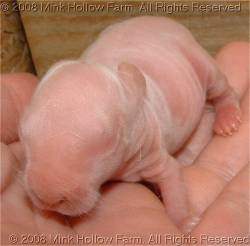 |
|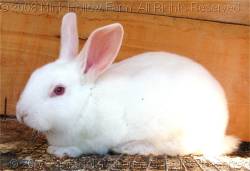 |
|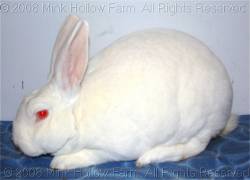 |
====== Full Extension (E-) ======
===== Full Colour (C-) =====
==== Agouti Group (A-) ====
The agouti group of colours carries the original (wild) colour pattern, where the body colour comes from hairs that are banded. The tip colour is determined by the B and D genes and is black in castors, chocolate in ambers, blue in opals, and lilac in lynxs. Next to it along the same hair shaft should be a red or orange colour in the castors and ambers (the redder the better), and a lighter fawn colour in the opals and lynxes, all allowing for a bluer hue in the blacks and a browner hue in the chocolates. Farther down the hair shaft is a blue colour which should be slate in the castors and opals and much lighter in ambers and lynx. The base is a light dove grey or white. The guard hairs are typically the ones that are tipped. The surface belly colour is tan, off-white, or white again, with the dilutes having the lighter colours. The undercolour should be the same as the undercolour of the body.
^ Agouti Patterns ^ This is the “natural” (wild) colour pattern. ^^^^^^^
^ Colour ^ A ^ B ^ C ^ D ^ E ^ En ^ ^
| Castor | A- | B- | C- | D- | E- | enen | This is the wild colour |
| Amber | A- | bb | C- | D- | E- | enen | |
| Opal | A- | B- | C- | dd | E- | enen | |
| Lynx | A- | bb | C- | dd | E- | enen | |
|
|
====== Full Extension (E-) ======
===== Full Colour (C-) =====
==== Agouti Group (A-) ====
The agouti group of colours carries the original (wild) colour pattern, where the body colour comes from hairs that are banded. The tip colour is determined by the B and D genes and is black in castors, chocolate in ambers, blue in opals, and lilac in lynxs. Next to it along the same hair shaft should be a red or orange colour in the castors and ambers (the redder the better), and a lighter fawn colour in the opals and lynxes, all allowing for a bluer hue in the blacks and a browner hue in the chocolates. Farther down the hair shaft is a blue colour which should be slate in the castors and opals and much lighter in ambers and lynx. The base is a light dove grey or white. The guard hairs are typically the ones that are tipped. The surface belly colour is tan, off-white, or white again, with the dilutes having the lighter colours. The undercolour should be the same as the undercolour of the body.
^ Agouti Patterns ^ This is the “natural” (wild) colour pattern. ^^^^^^^
^ Colour ^ A ^ B ^ C ^ D ^ E ^ En ^ ^
| Castor | A- | B- | C- | D- | E- | enen | This is the wild colour |
| Amber | A- | bb | C- | D- | E- | enen | |
| Opal | A- | B- | C- | dd | E- | enen | |
| Lynx | A- | bb | C- | dd | E- | enen | |
| 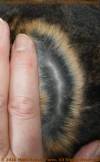 |
|  |
|  |
| 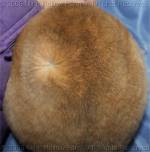 |
^ Castor ^ Castor ^ Amber ^ Amber ^
|
|
^ Castor ^ Castor ^ Amber ^ Amber ^
|  |
| 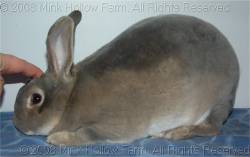 |
|  |
| 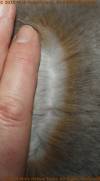 |
^ Opal ^ Opal ^ Lynx ^ Lynx ^
^ Chocolate vs. Amber ^ ^ Amber ^
|
|
^ Opal ^ Opal ^ Lynx ^ Lynx ^
^ Chocolate vs. Amber ^ ^ Amber ^
| 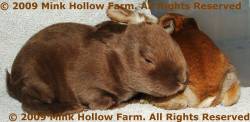 | |
| | 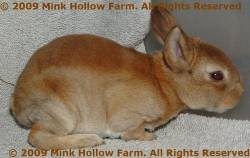 |
==== Otter Group (Tan: at-) ====
^ Tan Patterns ^ Note: the second gene in the 'A' pair can be either: at or a but not A ^^^^^^^
^ Colour ^ A ^ B ^ C ^ D ^ E ^ En ^ ^
| Black Otter | at- | B- | C- | D- | E- | enen | |
| Chocolate Otter | at- | bb | C- | D- | E- | enen | accepted into the official standard Feb. 2009 |
| Blue Otter | at- | B- | C- | dd | E- | enen | accepted into the official standard Feb. 2009 |
| lilac Otter | at- | bb | C- | dd | E- | enen | accepted into the official standard Feb. 2009 |
|
|
==== Otter Group (Tan: at-) ====
^ Tan Patterns ^ Note: the second gene in the 'A' pair can be either: at or a but not A ^^^^^^^
^ Colour ^ A ^ B ^ C ^ D ^ E ^ En ^ ^
| Black Otter | at- | B- | C- | D- | E- | enen | |
| Chocolate Otter | at- | bb | C- | D- | E- | enen | accepted into the official standard Feb. 2009 |
| Blue Otter | at- | B- | C- | dd | E- | enen | accepted into the official standard Feb. 2009 |
| lilac Otter | at- | bb | C- | dd | E- | enen | accepted into the official standard Feb. 2009 |
|  |
| 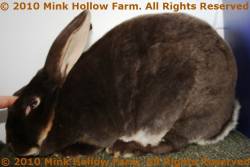 |
^ Black Otter ^ Chocolate Otter ^
|
|
^ Black Otter ^ Chocolate Otter ^
|  |
|  |
^ Blue Otter ^ Lilac Otter ^
==== Self Group (aa) ====
^ The Selfs (solid colour) ^ These “shades” exist in every colour and pattern. ^^^^^^^
^ Colour ^ A ^ B ^ C ^ D ^ E ^ En ^ ^
| Black | aa | B- | C- | D- | E- | enen | |
| Chocolate | aa | bb | C- | D- | E- | enen | |
| Blue | aa | B- | C- | dd | E- | enen | |
| Lilac | aa | bb | C- | dd | E- | enen | |
|
^ Blue Otter ^ Lilac Otter ^
==== Self Group (aa) ====
^ The Selfs (solid colour) ^ These “shades” exist in every colour and pattern. ^^^^^^^
^ Colour ^ A ^ B ^ C ^ D ^ E ^ En ^ ^
| Black | aa | B- | C- | D- | E- | enen | |
| Chocolate | aa | bb | C- | D- | E- | enen | |
| Blue | aa | B- | C- | dd | E- | enen | |
| Lilac | aa | bb | C- | dd | E- | enen | |
 Note the differences between these two littermates in the nestbox: one is blue and the other lilac. Both are dilute, but the lilac (left/middle) has brown instead of black. The other babies in this group are all blue & blue otter.
|
Note the differences between these two littermates in the nestbox: one is blue and the other lilac. Both are dilute, but the lilac (left/middle) has brown instead of black. The other babies in this group are all blue & blue otter.
|  |
|  |
^ Black ^ Chocolate ^
|
|
^ Black ^ Chocolate ^
|  |
| 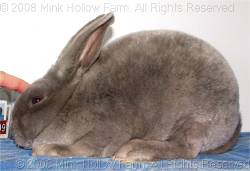 |
^ Blue ^ Lilac ^
===== Chinchilla (cchd) =====
==== Agouti (A-) Chinchilla ====
The second Shading Gene can be cchd, cchl, ch, or c, but not C
The chinchilla gene prevents some of the yellow pigment from forming, leaving the animal looking much like a 'black & white' version of the full colour. Since some yellow remains, the midband (and any other parts that would normally be red/yellow) will have a pearl colour rather than being white.
^ Chinchilla ^^^^^^^^
^ Colour ^ A ^ B ^ C ^ D ^ E ^ En ^ ^
| Chinchilla | A- | B- | cchd- | D- | E- | enen | |
| Chocolate Chinchilla | A- | bb | cchd- | D- | E- | enen | Not a recognized Rex Colour. |
| Squirrel (Blue Chinchilla) | A- | B- | cchd- | dd | E- | enen | Not a recognized Rex Colour. |
| Lilac Chinchilla | A- | bb | cchd- | dd | E- | enen | Not a recognized Rex Colour. |
^ Dark Chinchilla ^^^
|
|
^ Blue ^ Lilac ^
===== Chinchilla (cchd) =====
==== Agouti (A-) Chinchilla ====
The second Shading Gene can be cchd, cchl, ch, or c, but not C
The chinchilla gene prevents some of the yellow pigment from forming, leaving the animal looking much like a 'black & white' version of the full colour. Since some yellow remains, the midband (and any other parts that would normally be red/yellow) will have a pearl colour rather than being white.
^ Chinchilla ^^^^^^^^
^ Colour ^ A ^ B ^ C ^ D ^ E ^ En ^ ^
| Chinchilla | A- | B- | cchd- | D- | E- | enen | |
| Chocolate Chinchilla | A- | bb | cchd- | D- | E- | enen | Not a recognized Rex Colour. |
| Squirrel (Blue Chinchilla) | A- | B- | cchd- | dd | E- | enen | Not a recognized Rex Colour. |
| Lilac Chinchilla | A- | bb | cchd- | dd | E- | enen | Not a recognized Rex Colour. |
^ Dark Chinchilla ^^^
| |
| 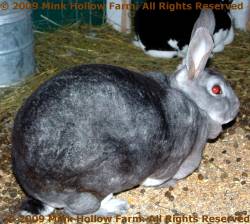 |
|  |
^ Chocolate Chinchilla ^^^
|
|
^ Chocolate Chinchilla ^^^
| 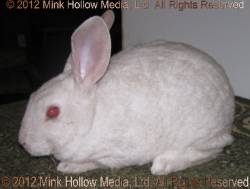 |
|  |
|  |
^ Squirrel (Blue Chinchilla) ^^^
|
|
^ Squirrel (Blue Chinchilla) ^^^
|  |
| 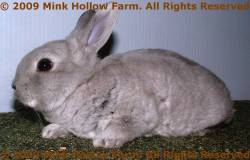 |
| 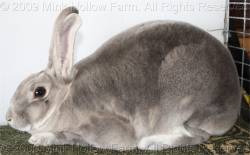 |
==== Otter Group (Tan: at-) Marten ====
^ Marten ^ Currently, none of these are recognized in Rex.^^^^^^^
^ Colour ^ A ^ B ^ C ^ D ^ E ^ En ^ ^
| Silver Marten | at- | B- | cchd- | D- | E- | enen | |
| Chocolate Silver Marten | at- | bb | cchd- | D- | E- | enen | |
| Blue Silver Marten | at- | B- | cchd- | dd | E- | enen | |
| Lilac Silver Marten | at- | bb | cchd- | dd | E- | enen | |
This is the colour you get when you combine the shaded gene (cchd) with the tan pattern (at-). It's an otter without the red colour along the borders. The chinchilla also makes the 'black' parts look slightly less black.
|
|
==== Otter Group (Tan: at-) Marten ====
^ Marten ^ Currently, none of these are recognized in Rex.^^^^^^^
^ Colour ^ A ^ B ^ C ^ D ^ E ^ En ^ ^
| Silver Marten | at- | B- | cchd- | D- | E- | enen | |
| Chocolate Silver Marten | at- | bb | cchd- | D- | E- | enen | |
| Blue Silver Marten | at- | B- | cchd- | dd | E- | enen | |
| Lilac Silver Marten | at- | bb | cchd- | dd | E- | enen | |
This is the colour you get when you combine the shaded gene (cchd) with the tan pattern (at-). It's an otter without the red colour along the borders. The chinchilla also makes the 'black' parts look slightly less black.
|  |
|  |
^ Marten ^ Otter ^
==== Self Group (aa) ====
^ Self Chinchilla ^ Phenotypically, these are almost indistinguishable from the full colour selfs.^^^^^^^
^ Colour ^ A ^ B ^ C ^ D ^ E ^ En ^ ^
| Black Self Chinchilla | aa | B- | cchd- | D- | E- | enen | Looks like a self black. |
| Chocolate Self Chinchilla | aa | bb | cchd- | D- | E- | enen | Looks like a self chocolate. |
| Blue Self Chinchilla | aa | B- | cchd- | dd | E- | enen | Looks like a self blue. |
| Lilac Self Chinchilla | aa | bb | cchd- | dd | E- | enen | Looks like a self lilac. |
===== Shaded (cchl) =====
Also called “Light Chinchilla”, or Sable.
This gene prevents ALL of the yellow pigment from forming along with some of the black. This means that there isn't even a 'pearl' colour, and the black isn't fully black, but rather sepia (dark brown). The difference between sepia and chocolate is something like dark vs milk chocolate.
The shaded allele is not fully dominant over the next two (ch : himalayan, and c : red-eyed white), so the results will look different depending on the second allele.
==== Sable Agouti Group (A-) ====
The second Shading Gene can be cchl, ch, or c, but not C or cchd.
The phenotype depends on the second allele.
^ Sable Agouti ^ These are often hard to distinguish from chinchillas.^^^^^^^
^ Colour ^ A ^ B ^ C ^ D ^ E ^ En ^ ^
| Sable Agouti | A- | B- | cchl- | D- | E- | enen | Looks like Chinchilla, but is often faulted for poor ring colour.|
| Chocolate Sable Agouti | A- | bb | cchl- | D- | E- | enen | Looks like a chocolate chin, but undercolour will be same as tipping. Not a recognized Rex Colour. |
| Blue Sable Agouti | A- | B- | cchl- | dd | E- | enen | Looks like a Squirrel (Blue Chin). Not a recognized Rex Colour. |
| Lilac Sable Agouti | A- | bb | cchl- | dd | E- | enen | Looks like a lilac chin. Not a recognized Rex Colour. |
==== Otter Group (Tan: at-) ====
^ Sable Marten ^ Currently, none of these are recognized in Rex.^^^^^^^
^ Colour ^ A ^ B ^ C ^ D ^ E ^ En ^ ^
| Sable Silver Marten | at- | B- | cchl- | D- | E- | enen | |
| Sable Chocolate Silver Marten | at- | bb | cchl- | D- | E- | enen | |
| Sable Blue Silver Marten | at- | B- | cchl- | dd | E- | enen | |
| Sable Lilac Silver Marten | at- | bb | cchl- | dd | E- | enen | |
==== Self Group (aa) ====
^ Self Sable ^^^^^^^^
^ Colour ^ A ^ B ^ C ^ D ^ E ^ En ^ ^
| Black Self Sable | aa | B- | cchlcchl | D- | E- | enen | Seal |
| Chocolate Self Sable | aa | bb | cchlcchl | D- | E- | enen | Chocolate Smoke Pearl |
| Blue Self Sable | aa | B- | cchlcchl | dd | E- | enen | Smoke Pearl |
| Lilac Self Sable | aa | bb | cchlcchl | dd | E- | enen | Lilac Smoke Pearl |
|
|
^ Marten ^ Otter ^
==== Self Group (aa) ====
^ Self Chinchilla ^ Phenotypically, these are almost indistinguishable from the full colour selfs.^^^^^^^
^ Colour ^ A ^ B ^ C ^ D ^ E ^ En ^ ^
| Black Self Chinchilla | aa | B- | cchd- | D- | E- | enen | Looks like a self black. |
| Chocolate Self Chinchilla | aa | bb | cchd- | D- | E- | enen | Looks like a self chocolate. |
| Blue Self Chinchilla | aa | B- | cchd- | dd | E- | enen | Looks like a self blue. |
| Lilac Self Chinchilla | aa | bb | cchd- | dd | E- | enen | Looks like a self lilac. |
===== Shaded (cchl) =====
Also called “Light Chinchilla”, or Sable.
This gene prevents ALL of the yellow pigment from forming along with some of the black. This means that there isn't even a 'pearl' colour, and the black isn't fully black, but rather sepia (dark brown). The difference between sepia and chocolate is something like dark vs milk chocolate.
The shaded allele is not fully dominant over the next two (ch : himalayan, and c : red-eyed white), so the results will look different depending on the second allele.
==== Sable Agouti Group (A-) ====
The second Shading Gene can be cchl, ch, or c, but not C or cchd.
The phenotype depends on the second allele.
^ Sable Agouti ^ These are often hard to distinguish from chinchillas.^^^^^^^
^ Colour ^ A ^ B ^ C ^ D ^ E ^ En ^ ^
| Sable Agouti | A- | B- | cchl- | D- | E- | enen | Looks like Chinchilla, but is often faulted for poor ring colour.|
| Chocolate Sable Agouti | A- | bb | cchl- | D- | E- | enen | Looks like a chocolate chin, but undercolour will be same as tipping. Not a recognized Rex Colour. |
| Blue Sable Agouti | A- | B- | cchl- | dd | E- | enen | Looks like a Squirrel (Blue Chin). Not a recognized Rex Colour. |
| Lilac Sable Agouti | A- | bb | cchl- | dd | E- | enen | Looks like a lilac chin. Not a recognized Rex Colour. |
==== Otter Group (Tan: at-) ====
^ Sable Marten ^ Currently, none of these are recognized in Rex.^^^^^^^
^ Colour ^ A ^ B ^ C ^ D ^ E ^ En ^ ^
| Sable Silver Marten | at- | B- | cchl- | D- | E- | enen | |
| Sable Chocolate Silver Marten | at- | bb | cchl- | D- | E- | enen | |
| Sable Blue Silver Marten | at- | B- | cchl- | dd | E- | enen | |
| Sable Lilac Silver Marten | at- | bb | cchl- | dd | E- | enen | |
==== Self Group (aa) ====
^ Self Sable ^^^^^^^^
^ Colour ^ A ^ B ^ C ^ D ^ E ^ En ^ ^
| Black Self Sable | aa | B- | cchlcchl | D- | E- | enen | Seal |
| Chocolate Self Sable | aa | bb | cchlcchl | D- | E- | enen | Chocolate Smoke Pearl |
| Blue Self Sable | aa | B- | cchlcchl | dd | E- | enen | Smoke Pearl |
| Lilac Self Sable | aa | bb | cchlcchl | dd | E- | enen | Lilac Smoke Pearl |
| 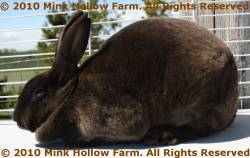 |
| 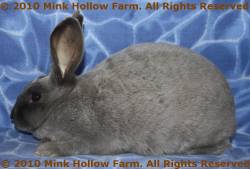 |
^ Seal (self shaded) ^ Smoke Pearl (self blue shaded) ^
Sable Pointed varieties require the second allele to be h (himalayan) or c (rew). All the sable points become lighter when the second shading gene is c instead of ch
^ Sable Pointed ^^^^^^^^
^ Colour ^ A ^ B ^ C ^ D ^ E ^ En ^ ^
| Sable Point | aa | B- | cchlch | D- | E- | enen | Sable |
| Chocolate Sable Point | aa | bb | cchlch | D- | E- | enen | Chocolate Sable |
| Blue Sable Point | aa | B- | cchlch | dd | E- | enen | Blue Sable |
| Lilac Sable Point | aa | bb | cchlch | dd | E- | enen | Lilac Sable |
===== Himalayan (ch) =====
The Himalayan gene restricts colour to the extremities. Most standards that allow this colour call for all 'useable' portions of the pelt to be white.
This allele is affected by temperature - pigment forms only where the skin is exposed to coll temperatures. Skin that is kept warm will grow hair lacking pigment (i.e. white).
|
|
^ Seal (self shaded) ^ Smoke Pearl (self blue shaded) ^
Sable Pointed varieties require the second allele to be h (himalayan) or c (rew). All the sable points become lighter when the second shading gene is c instead of ch
^ Sable Pointed ^^^^^^^^
^ Colour ^ A ^ B ^ C ^ D ^ E ^ En ^ ^
| Sable Point | aa | B- | cchlch | D- | E- | enen | Sable |
| Chocolate Sable Point | aa | bb | cchlch | D- | E- | enen | Chocolate Sable |
| Blue Sable Point | aa | B- | cchlch | dd | E- | enen | Blue Sable |
| Lilac Sable Point | aa | bb | cchlch | dd | E- | enen | Lilac Sable |
===== Himalayan (ch) =====
The Himalayan gene restricts colour to the extremities. Most standards that allow this colour call for all 'useable' portions of the pelt to be white.
This allele is affected by temperature - pigment forms only where the skin is exposed to coll temperatures. Skin that is kept warm will grow hair lacking pigment (i.e. white).
|  |
|  |
^ Black Californian (young) ^ Chocolate Californian (not showable) ^
The second colour allele can only be ch, or c. Points will have better colour if it is homozygous for Himalayan (chch)
==== Agouti Group (A-) ====
^ Agouti Himalayan ^^^^^^^^
^ Colour ^ A ^ B ^ C ^ D ^ E ^ En ^ ^
| Himalayan | A- | B- | ch- | D- | E- | enen |Possibly showable as a Californian (Black Himalayan) Would likely be faulted for poor point colour. |
| Chocolate Agouti Himalayan | A- | bb | ch- | D- | E- | enen | Not a recognized Rex Colour. |
| Blue Agouti Himalayan | A- | B- | ch- | dd | E- | enen | Not a recognized Rex Colour. |
| Lilac Agouti Himalayan | A- | bb | ch- | dd | E- | enen | Not a recognized Rex Colour. |
==== Otter Group (Tan at-) ====
^ Tan Himalayan ^ Currently, none of these are recognized in Rex.^^^^^^^
^ Colour ^ A ^ B ^ C ^ D ^ E ^ En ^ ^
| Black Tan Himalayan | at- | B- | ch- | D- | E- | enen | Possibly showable as a Californian (Black Himalayan) Would likely be faulted for poor point colour.|
| Chocolate Tan Himalayan | at- | bb | ch- | D- | E- | enen | |
| Blue Tan Himalayan | at- | B- | ch- | dd | E- | enen | |
| Lilac Tan Himalayan | at- | bb | ch- | dd | E- | enen | |
==== Self Group (aa) ====
The self coloured Himalayan is the only one recognized in most breeds.
^ Self Himalayan ^^^^^^^^
^ Colour ^ A ^ B ^ C ^ D ^ E ^ En ^ ^
| Black Himalayan | aa | B- | ch- | D- | E- | enen | Only Himi Colour recognized in Rex. |
| Chocolate Himalayan | aa | bb | ch- | D- | E- | enen | |
| Blue Himalayan | aa | B- | ch- | dd | E- | enen | |
| Lilac Himalayan | aa | bb | ch- | dd | E- | enen | |
====== Non-Extension (ee) ======
===== Full Colour (C-) =====
==== Agouti Group (A-) Red & Fawn ====
Only the Red is recognized in North America. It makes use of the recessive ee non-extension gene. It is the only rex colour to make use of the recessive Wide Band gene (W) which fills the entire hair shaft with the mid band colour. Genetically speaking, the difference between a Red and a Tort is that the Red has the Agouti pattern, while the tort is a self. The tort will always show darker points and belly colour, and can usually be identified at birth.
An Agouti (A-) rabbit with non-extension (ee) but without the wide band (ww) will look more like a red or fawn than a tort, but will have lighter than ideal markings around the eyes, and on the belly. Ideally, these should carry the colour right to the skin, with NO difference in the belly colours. Since the midband is carried right to the tips, there should be no noticeable difference between the black and chocolate; or the blue and lilac.
^ Fawn (Lilac) ^ Fawn (Lilac) ^ Lynx ^ Lynx vs Fawn (Lilac) ^
|
|
^ Black Californian (young) ^ Chocolate Californian (not showable) ^
The second colour allele can only be ch, or c. Points will have better colour if it is homozygous for Himalayan (chch)
==== Agouti Group (A-) ====
^ Agouti Himalayan ^^^^^^^^
^ Colour ^ A ^ B ^ C ^ D ^ E ^ En ^ ^
| Himalayan | A- | B- | ch- | D- | E- | enen |Possibly showable as a Californian (Black Himalayan) Would likely be faulted for poor point colour. |
| Chocolate Agouti Himalayan | A- | bb | ch- | D- | E- | enen | Not a recognized Rex Colour. |
| Blue Agouti Himalayan | A- | B- | ch- | dd | E- | enen | Not a recognized Rex Colour. |
| Lilac Agouti Himalayan | A- | bb | ch- | dd | E- | enen | Not a recognized Rex Colour. |
==== Otter Group (Tan at-) ====
^ Tan Himalayan ^ Currently, none of these are recognized in Rex.^^^^^^^
^ Colour ^ A ^ B ^ C ^ D ^ E ^ En ^ ^
| Black Tan Himalayan | at- | B- | ch- | D- | E- | enen | Possibly showable as a Californian (Black Himalayan) Would likely be faulted for poor point colour.|
| Chocolate Tan Himalayan | at- | bb | ch- | D- | E- | enen | |
| Blue Tan Himalayan | at- | B- | ch- | dd | E- | enen | |
| Lilac Tan Himalayan | at- | bb | ch- | dd | E- | enen | |
==== Self Group (aa) ====
The self coloured Himalayan is the only one recognized in most breeds.
^ Self Himalayan ^^^^^^^^
^ Colour ^ A ^ B ^ C ^ D ^ E ^ En ^ ^
| Black Himalayan | aa | B- | ch- | D- | E- | enen | Only Himi Colour recognized in Rex. |
| Chocolate Himalayan | aa | bb | ch- | D- | E- | enen | |
| Blue Himalayan | aa | B- | ch- | dd | E- | enen | |
| Lilac Himalayan | aa | bb | ch- | dd | E- | enen | |
====== Non-Extension (ee) ======
===== Full Colour (C-) =====
==== Agouti Group (A-) Red & Fawn ====
Only the Red is recognized in North America. It makes use of the recessive ee non-extension gene. It is the only rex colour to make use of the recessive Wide Band gene (W) which fills the entire hair shaft with the mid band colour. Genetically speaking, the difference between a Red and a Tort is that the Red has the Agouti pattern, while the tort is a self. The tort will always show darker points and belly colour, and can usually be identified at birth.
An Agouti (A-) rabbit with non-extension (ee) but without the wide band (ww) will look more like a red or fawn than a tort, but will have lighter than ideal markings around the eyes, and on the belly. Ideally, these should carry the colour right to the skin, with NO difference in the belly colours. Since the midband is carried right to the tips, there should be no noticeable difference between the black and chocolate; or the blue and lilac.
^ Fawn (Lilac) ^ Fawn (Lilac) ^ Lynx ^ Lynx vs Fawn (Lilac) ^
|  |
|  |
|  |
| 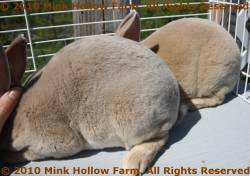 |
|These two are sisters. The difference is noticeable at birth - the fawn lacks the pattern markings typical of an agouti, and the tipping is absent when the hair first starts to come in (the lynx looks like a lilac agouti while the fawn looks like a self). ||||
in Rex, there is some disagreement over the correct genotype for the Lynx variety: some people say it should be a genetic lilac agouti, while others say it should be a Fawn.
^ Agouti Patterns ^ This is the “natural” (wild) colour pattern. ^^^^^^^
^ Colour ^ A ^ B ^ C ^ D ^ E ^ En ^ ^
| Red | A- | B- | C- | D- | ee | enen | |
| Red | A- | bb | C- | D- | ee | enen | |
| Fawn | A- | B- | C- | dd | ee | enen |Not recognized in Rex. |
| Fawn | A- | bb | C- | dd | ee | enen |Not recognized in Rex. |
==== Otter Group (Tan: at-) ====
The non-extension tan (otter) will show both some tort shading *and* the typical tan markings (light surface colour underneath, with a red border between the body colour and the belly, around the eyes, inside and behind the ears)
^ Tan Patterns ^ Fox ^^^^^^^
^ Colour ^ A ^ B ^ C ^ D ^ E ^ En ^ ^
| Black Fox | at- | B- | C- | D- | ee | enen | |
| Chocolate Fox | at- | bb | C- | D- | ee | enen | |
| Blue Fox | at- | B- | C- | dd | ee | enen | |
| lilac Fox | at- | bb | C- | dd | ee | enen | |
|
|
|These two are sisters. The difference is noticeable at birth - the fawn lacks the pattern markings typical of an agouti, and the tipping is absent when the hair first starts to come in (the lynx looks like a lilac agouti while the fawn looks like a self). ||||
in Rex, there is some disagreement over the correct genotype for the Lynx variety: some people say it should be a genetic lilac agouti, while others say it should be a Fawn.
^ Agouti Patterns ^ This is the “natural” (wild) colour pattern. ^^^^^^^
^ Colour ^ A ^ B ^ C ^ D ^ E ^ En ^ ^
| Red | A- | B- | C- | D- | ee | enen | |
| Red | A- | bb | C- | D- | ee | enen | |
| Fawn | A- | B- | C- | dd | ee | enen |Not recognized in Rex. |
| Fawn | A- | bb | C- | dd | ee | enen |Not recognized in Rex. |
==== Otter Group (Tan: at-) ====
The non-extension tan (otter) will show both some tort shading *and* the typical tan markings (light surface colour underneath, with a red border between the body colour and the belly, around the eyes, inside and behind the ears)
^ Tan Patterns ^ Fox ^^^^^^^
^ Colour ^ A ^ B ^ C ^ D ^ E ^ En ^ ^
| Black Fox | at- | B- | C- | D- | ee | enen | |
| Chocolate Fox | at- | bb | C- | D- | ee | enen | |
| Blue Fox | at- | B- | C- | dd | ee | enen | |
| lilac Fox | at- | bb | C- | dd | ee | enen | |
|  |
| 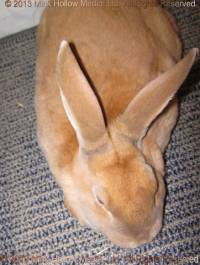 |
|  |
|
|
| 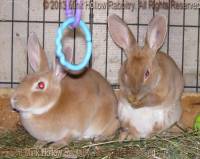 |
| This image shows a fox and her red sister. |
==== Self Group (aa) The Pointed Group (aka Tort) ====
These all have dark points (nose, ears, feet,…) and a lighter body. None of these are recognized in Rex. All carry the self pattern (aa).
None are recognized in Rex.
^ The Selfs (solid colour) ^Tortoiseshell ^^^^^^^
^ Colour ^ A ^ B ^ C ^ D ^ E ^ En ^ ^
| Black Tort | aa | B- | C- | D- | ee | enen | |
| Chocolate Tort | aa | bb | C- | D- | ee | enen | |
| Blue Tort | aa | B- | C- | dd | ee | enen | |
| Lilac Tort | aa | bb | C- | dd | ee | enen | |
^ Black Tort ^^^
|
|
| This image shows a fox and her red sister. |
==== Self Group (aa) The Pointed Group (aka Tort) ====
These all have dark points (nose, ears, feet,…) and a lighter body. None of these are recognized in Rex. All carry the self pattern (aa).
None are recognized in Rex.
^ The Selfs (solid colour) ^Tortoiseshell ^^^^^^^
^ Colour ^ A ^ B ^ C ^ D ^ E ^ En ^ ^
| Black Tort | aa | B- | C- | D- | ee | enen | |
| Chocolate Tort | aa | bb | C- | D- | ee | enen | |
| Blue Tort | aa | B- | C- | dd | ee | enen | |
| Lilac Tort | aa | bb | C- | dd | ee | enen | |
^ Black Tort ^^^
|  |
|  |
| 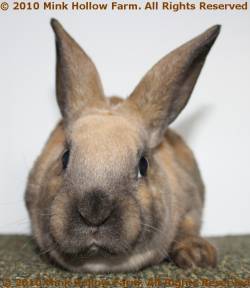 |
===== Chinchilla Group (cchd) =====
==== Agouti Group (A-) Ermine ====
NOT A RECOGNIZED COLOUR IN REX
This is the colour you get when you combine the shaded gene (cchd or cchl) with non-extension (ee). The animal will look white but if you compare it against a true albino (rew) you will see that the eye has colour (albinos have NO colour so all you see is the pink from the blood vessels in the eye) and that there is a slight ticking on the coat. The colour of the eye and ticking will provide a clue as to whether or not it is black, blue, chocolate, or lilac, although it is difficult to distinguish black from chocolate and blue from lilac as so much of the colour is removed by the shading gene.
|
|
===== Chinchilla Group (cchd) =====
==== Agouti Group (A-) Ermine ====
NOT A RECOGNIZED COLOUR IN REX
This is the colour you get when you combine the shaded gene (cchd or cchl) with non-extension (ee). The animal will look white but if you compare it against a true albino (rew) you will see that the eye has colour (albinos have NO colour so all you see is the pink from the blood vessels in the eye) and that there is a slight ticking on the coat. The colour of the eye and ticking will provide a clue as to whether or not it is black, blue, chocolate, or lilac, although it is difficult to distinguish black from chocolate and blue from lilac as so much of the colour is removed by the shading gene.
|  |
|  |
^ Ermine ^ Red-Eyed White (albino) ^
The second Shading Gene can be cchd, cchl, ch, or c, but not C, and c gives the best ermine effect.
==== Otter Group (Tan: at-) ====
NOT A RECOGNIZED COLOUR IN REX
==== Self Group (aa) Sallander ====
NOT A RECOGNIZED COLOUR IN REX
This is the colour you get when you combine the shaded gene (cchd) with a tort (aa ee). You get the same kind of patterns as you would with a tort, but of course the cchd chinchilla gets rid of most of the yellow (red).
|
|
^ Ermine ^ Red-Eyed White (albino) ^
The second Shading Gene can be cchd, cchl, ch, or c, but not C, and c gives the best ermine effect.
==== Otter Group (Tan: at-) ====
NOT A RECOGNIZED COLOUR IN REX
==== Self Group (aa) Sallander ====
NOT A RECOGNIZED COLOUR IN REX
This is the colour you get when you combine the shaded gene (cchd) with a tort (aa ee). You get the same kind of patterns as you would with a tort, but of course the cchd chinchilla gets rid of most of the yellow (red).
|  |
|  |
^ Sallander (broken) ^ Tort ^
The second Shading Gene can be cchd, cchl, ch, or c, but not C
===== Shaded (cchl) =====
==== Agouti Group (A-) ====
==== Otter Group (Tan: at-) ====
==== Self Group (aa) ====
===== Himalayan (h) =====
==== Agouti Group (A-) ====
==== Otter Group (Tan: at-) ====
==== Self Group (aa) ====
====== Random Extension (ej-) ======
This allele gives us harlequin, or brindled colours. The extension genes here can be ejej or eje
This gene is not completely recessive to E which means that a rabbit that is Eej will show some brindling. This can almost always be seen on an agouti (A-) or tan (At-) but may be hidden in a self (aa). It is easiest to see inside the ears. Notice how the brindle seems to be trying to come through as spots on the broken castor below.
|
|
^ Sallander (broken) ^ Tort ^
The second Shading Gene can be cchd, cchl, ch, or c, but not C
===== Shaded (cchl) =====
==== Agouti Group (A-) ====
==== Otter Group (Tan: at-) ====
==== Self Group (aa) ====
===== Himalayan (h) =====
==== Agouti Group (A-) ====
==== Otter Group (Tan: at-) ====
==== Self Group (aa) ====
====== Random Extension (ej-) ======
This allele gives us harlequin, or brindled colours. The extension genes here can be ejej or eje
This gene is not completely recessive to E which means that a rabbit that is Eej will show some brindling. This can almost always be seen on an agouti (A-) or tan (At-) but may be hidden in a self (aa). It is easiest to see inside the ears. Notice how the brindle seems to be trying to come through as spots on the broken castor below.
| 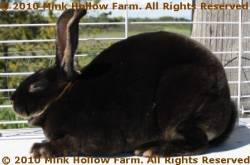 |
| 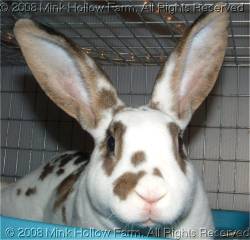 |
|  |
^ An otter that is Eej ^ A Broken Castor that is also Eej ^^
It can be tricky to tell if a harlequin is an agouti (A-) or a self (aa) as both will show the same brindling patterns. The agouti pattern can sometimes still be seen though - it will be most obvious around the eyes, under the chin and tail, and on the belly, where you will often be able to see the light colouring typical of an agouti. The only way to tell for sure is through test-breeding of course - breed it to a self coloured- rabbit and if ANY agoutis show up in the litter then the rabbit is carrying agouti.
A self coloured (aa) broken harelequin will usually look like a tri-colour, but if it is also heterozygous for random & non-extension (eje) it can also end up looking more like a broken tort with some darker spots. These are sometimes called Torted Tri's.
===== Full Colour (C-) =====
In the Rex, the un-broken version of harlequin (ejej or eje) results in bands of colour (brindling), ideally alternating (as in the Harlequin breed), but it is not showable.
When combined with the broken pattern (Enen) the coloured parts become orange with black or chocolate spots, or fawn with blue or lilac spots. These can be shown in the broken group. This MUST be a broken pattern to be acceptable in Rex.
^ Tri-Colour ^^^^^^^^
^ Colour ^ A ^ B ^ C ^ D ^ E ^ En ^ ^
| Dense Black & Golden Orange | A- | B- | C- | D- | ejej | Enen | |
| Chocolate & Golden Orange | A- | bb | C- | D- | ejej | Enen | |
| Lavender Blue & Golden Fawn | A- | B- | C- | dd | ejej | Enen | |
| Dove Gray & Golden Fawn | A- | bb | C- | dd | ejej | Enen | |
|
|
^ An otter that is Eej ^ A Broken Castor that is also Eej ^^
It can be tricky to tell if a harlequin is an agouti (A-) or a self (aa) as both will show the same brindling patterns. The agouti pattern can sometimes still be seen though - it will be most obvious around the eyes, under the chin and tail, and on the belly, where you will often be able to see the light colouring typical of an agouti. The only way to tell for sure is through test-breeding of course - breed it to a self coloured- rabbit and if ANY agoutis show up in the litter then the rabbit is carrying agouti.
A self coloured (aa) broken harelequin will usually look like a tri-colour, but if it is also heterozygous for random & non-extension (eje) it can also end up looking more like a broken tort with some darker spots. These are sometimes called Torted Tri's.
===== Full Colour (C-) =====
In the Rex, the un-broken version of harlequin (ejej or eje) results in bands of colour (brindling), ideally alternating (as in the Harlequin breed), but it is not showable.
When combined with the broken pattern (Enen) the coloured parts become orange with black or chocolate spots, or fawn with blue or lilac spots. These can be shown in the broken group. This MUST be a broken pattern to be acceptable in Rex.
^ Tri-Colour ^^^^^^^^
^ Colour ^ A ^ B ^ C ^ D ^ E ^ En ^ ^
| Dense Black & Golden Orange | A- | B- | C- | D- | ejej | Enen | |
| Chocolate & Golden Orange | A- | bb | C- | D- | ejej | Enen | |
| Lavender Blue & Golden Fawn | A- | B- | C- | dd | ejej | Enen | |
| Dove Gray & Golden Fawn | A- | bb | C- | dd | ejej | Enen | |
|  |
| 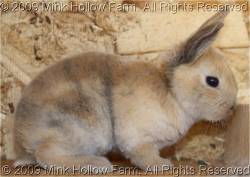 |
|  |
| This is a blue-cream (or blue-fawn) harlequin || A young blue-fawn tri. |
|
|
| This is a blue-cream (or blue-fawn) harlequin || A young blue-fawn tri. |
|  |
|  |
| 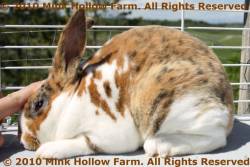 |
| These are black-orange harlequin. || A young black-orange tri. |
^ Black/Orange Tri ^^^
|
|
| These are black-orange harlequin. || A young black-orange tri. |
^ Black/Orange Tri ^^^
|  |
|  |
| 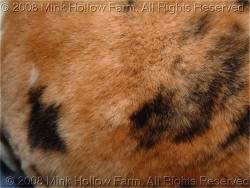 |
==== Agouti Group (A-) ====
==== Otter Group (Tan: at-) ====
==== Self Group (aa) ====
===== Chinchilla Group (cchd) =====
==== Agouti Group (A-) ====
==== Otter Group (Tan: at-) ====
==== Self Group (aa) ====
===== Shaded Group(cchl) =====
==== Agouti Group (A-) ====
==== Otter Group (Tan: at-) ====
==== Self Group (aa) ====
===== Himalayan (h) =====
==== Agouti Group (A-) ====
==== Otter Group (Tan: at-) ====
==== Self Group (aa) ====
===== Further Resources =====
Wild River Rabbitry has a lovely illustrated Shaded Mini Rex Guide.
Judith Graf, Color Basics 1991 (self-published booklet)
Glenna M.Huffmon, The Basics of Color Genetics in Rabbits (I have the 1995 third edition)
|
==== Agouti Group (A-) ====
==== Otter Group (Tan: at-) ====
==== Self Group (aa) ====
===== Chinchilla Group (cchd) =====
==== Agouti Group (A-) ====
==== Otter Group (Tan: at-) ====
==== Self Group (aa) ====
===== Shaded Group(cchl) =====
==== Agouti Group (A-) ====
==== Otter Group (Tan: at-) ====
==== Self Group (aa) ====
===== Himalayan (h) =====
==== Agouti Group (A-) ====
==== Otter Group (Tan: at-) ====
==== Self Group (aa) ====
===== Further Resources =====
Wild River Rabbitry has a lovely illustrated Shaded Mini Rex Guide.
Judith Graf, Color Basics 1991 (self-published booklet)
Glenna M.Huffmon, The Basics of Color Genetics in Rabbits (I have the 1995 third edition)

